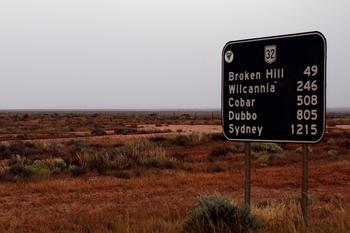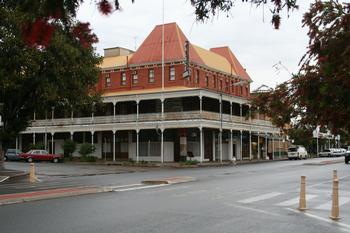| A | U | S | T | R | A | L | I | A | 2 |
0 |
0 |
5 |
 |
 |
 |
 |
Total: 1455 |
Oct 29 |
 |
Adelaide-Broken Hill
Internet access may be all over the place these days, but you still have to be in the right place at the right time. Even Adelaide couldn't help when we arrived after 11pm and were away again by 8 the next morning.
It is raining again—hard. The first order of business today is a bus out to the airport to pick up the final hire car. Actually the first order of business is for Wayne to go birding, and for me to try once again to download the camera chips onto CD. I've been told that the place I used last time opens at 6am, and I'm there soon after that. Sure, they open at 6:00am, but the Internet/camera stuff can't open until the 9:00am guy shows up. I run back to the hotel, but miss Wayne by 10 minutes.
We finally reconnect and make a destination decision. Going north (directly into the outback) is much more likely to fix the rain. Wayne's seen most of the birds he was hoping to find in the parks south of here, and going north cuts down considerably on the driving, plus gains us a day on the cross-country thing. We've already had our eye on Menindee, south-east of Broken Hill which is reputed to be a spectacular park for wildlife, especially the water birds which gather on its substantial lakes. Broken Hill is more than 300 miles, and it is 10:00am before we finally extract the car from the airport rental folks, but with some open road and a little luck, this shouldn't be a problem. We drive for a couple of hours in unpromising conditions—suburbs, rain.
There are two or three people sitting around on old kitchen chairs drinking beer. "No power." "No gas?" "No, no electricity. How much gas you got?" "About a quarter of a tank, a little less." No worries, go on to Broken Hill." Easy for you to say. We resolve never to pass another gas station with less than half a tank. But he's right of course, and we cruise into Broken Hill soon after the reserve lights up. We're now seriously into the outback but it's clearly been raining here too, and recently. I ask the guy in the gas station how often it rains here. "When she can, I reckon."
Although the largest town in the outback, it's still a tiny community. Since everything else is shut, we finally have time to just sit in the bar and watch. But by about 8 we can't stay awake so retire to our room. At 9, the volume of the music suddenly cranks to bed-rattling volume. Just as suddenly it stopped again at 11.30, but the laughing and shouting went on for several more hours after that.
|
|
|
|
| Emu Broken Hill The largest town in the west, Broken Hill stands on the richest silver-lead-zinc deposit yet discovered and has so far yielded minerals worth over 1.5 billion dollars. Its famous "Line of Lode", one of the world's major lead-silver-zinc ore bodies and the city's raison d'être, still has a little life left in it after being mined continuously for over 110 years. The town, situated in one of the driest areas of Australia is surprisingly green and leafy thanks to water piped from the reservoir at Lake Menindee 110km away. Broken Hill was named in 1844 by explorer Sturt but the mineral riches were not discovered until 1883 by Charles Rasp after which a town grew almost instantly to a population 20,000 within eight years. One of the most striking aspects of the town, apart from the number of pubs, is the remarkable aridity of the region. Drive out to the start of the Mundi Mundi Plain, NW of the town, and the desert around you doesn't fundamentally change until you reach the coast of Western Australia. Broken Hill is literally an oasis in the desert, a place of green parks and gardens. It can get very hot in summer but it is rare for the daily maximum to exceed 38C for more than 8 or 9 days a year. Broken Hill celebrated its centenary in 1988. Inevitably, Broken Hill revolves around the mines, but in the last decade it has also evolved into a thriving arts center, thanks to the initiative of the Brushmen of the Bush, a painting school founded by local artists. Diverse talents have been attracted to Broken Hill, and their works are displayed in galleries scattered all over town. Most of the notable buildings are in Argent St. At the corner with Chloride St is the red-brick Post Office (1890-92), designed by James Barnet, with its massive turret capped by a decorative mansard roof and enveloped by a footpath verandah and corner balcony. Next door is the town's architectural highlight, the extraordinarily ornate Town Hall (1890-91). Next to it is the modest Police station (1890). It replaced an earlier tin shed in which the prisoners were chained to the flooring joists, although if a female prisoner was present they were chained to the station fence outside! There are also a number of historic hotels. The most impressive of these is the large, three-story Palace Hotel (1889) with its lengthy verandahs and elaborate cast-iron balustrades. It was used in the movie Priscilla, Queen of the Desert which was shot here in 1993. |
||



